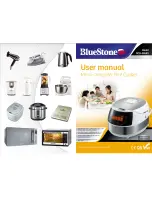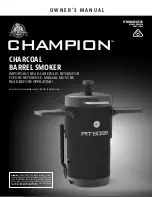
23
Defrosting
Use
3
CircoTherm® to defrost and cook frozen products.
Notes
■
Frozen products that have been defrosted (meat in particular)
require shorter cooking times than fresh products
■
The cooking time for frozen meat increases by the defrosting
time
■
Always defrost frozen poultry before cooking so that you can
remove the giblets
■
Cook frozen fish at the same temperatures as fresh fish
■
You can place large quantities of ready made frozen
vegetables in aluminium dishes in the cooking compartment
at the same time
■
Use shelf height 1 when defrosting on one level, and shelf
heights 1 + 3 when using two levels
■
Observe the instructions on the packaging when using frozen
foods.
Preserve
ã=
Risk of injury!
Preserving jars containing incorrectly preserved food can burst.
Please observe the following instructions:
■
Fruit and vegetables must be fresh and in good condition
■
Only use clean and undamaged preserving jars
■
The preserving jars must not touch each other in the cooking
compartment during preserving
With
3
CircoTherm® , the cooking compartment can be used
to preserve the contents of up to six ½, 1 or 1½ litre preserving
jars at the same time.
Notes
■
For each preserving process, only use preserving jars that
are the same size and contain the same food.
■
Pay attention to cleanliness when preparing and closing the
preserving jars.
■
Only use heat resistant rubber rings.
■
You cannot preserve the following food in your appliance: the
contents of tin cans, meat, fish or pie filling.
Preparing fruit
1.
Wash fruit and, depending on the type, peel, remove the
seeds and finely chop.
2.
Fill the preserving jars with fruit up to approx. 2 cm below the
rim.
3.
Fill the preserving jars with hot, skimmed sugar solution
(approx.
Y
l for a one litre jar).
To one litre water:
■
approx. 250 g sugar for sweet fruit
■
approx. 500 g sugar for sour fruit
Preparing vegetables
1.
Wash vegetables and depending on the type, clean and finely
chop.
2.
Fill the preserving jars with vegetables up to approx. 2 cm
below the rim.
3.
Fill the preserving jars immediately with hot, boiled water.
Closing the preserving jars
1.
Wipe the rims of the preserving jars with a clean, damp cloth.
2.
Put a wet rubber ring and lid in place and close the jars with
the clips.
Starting the preserving process
1.
Insert the universal pan at shelf height 1.
2.
Position the preserving jars in a triangle without them
touching each other.
3.
Pour ½ litre of hot water (approx. 80 °C) into the universal
pan.
4.
Set
3
CircoTherm® at 160 °C.
■
Preserving jars containing ½ or 1 litre will start to bubble
after approx. 50 minutes
■
Preserving jars containing 1½ litres will start to bubble after
approx. 60 minutes
Ending the preserving process
For fruit, gherkins and tomato purée:
1.
Turn off the appliance, once all preserving jars are bubbling.
2.
Allow the preserving jars to stand in the closed cooking
compartment for several minutes longer.
■
Raspberries, strawberries, cherries or gherkins: approx.
5 - 10 minutes
■
Other fruit: approx. 10 - 15 minutes
■
Tomato or apple purée: approx. 15 - 20 minutes
For vegetables:
1.
Reduce the temperature to 100 °C once all the preserving
jars are bubbling. Allow the preserving jars to continue
bubbling for approx.60 minutes in the closed cooking
compartment.
2.
Switch off the appliance.
3.
Allow the preserving jars to stand in the closed cooking
compartment for approx. 15 - 30 minutes longer.
Removing the preserving jars
1.
Place the preserving jars on a clean cloth, cover and protect
from draughts.
2.
Remove clips only when the jars are cold.
Frozen meals
Tempera-
ture in °C
Defrosting
time in min-
utes
Raw frozen products/ foods
50
30 - 90
Bread/Bread rolls (750 - 1,500 g)
50
30 - 60
Dry, frozen tray bakes
60
45 - 60
Moist, frozen tray bakes
50
50 - 70
Summary of Contents for E86E74.1MC
Page 1: ...en Instruction manual Built in cooker E86E74 1MC...
Page 31: ...31...










































